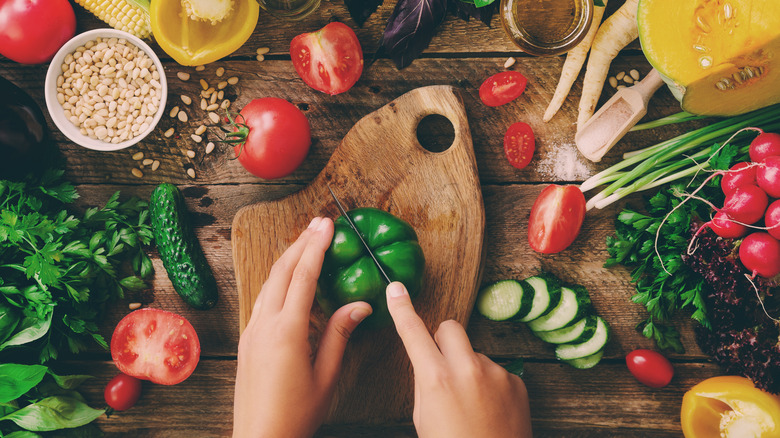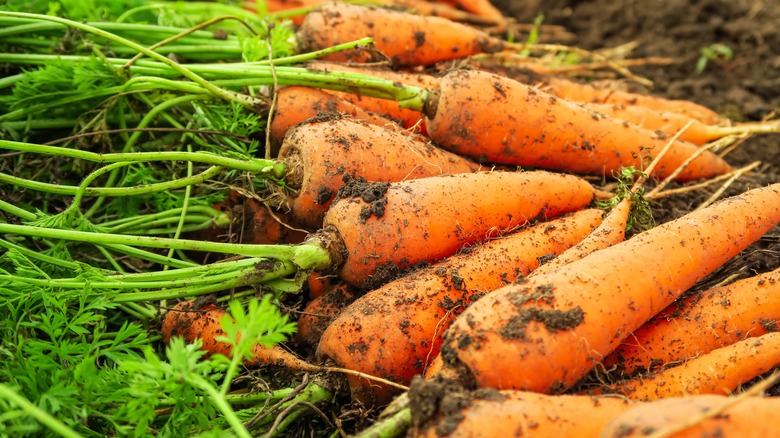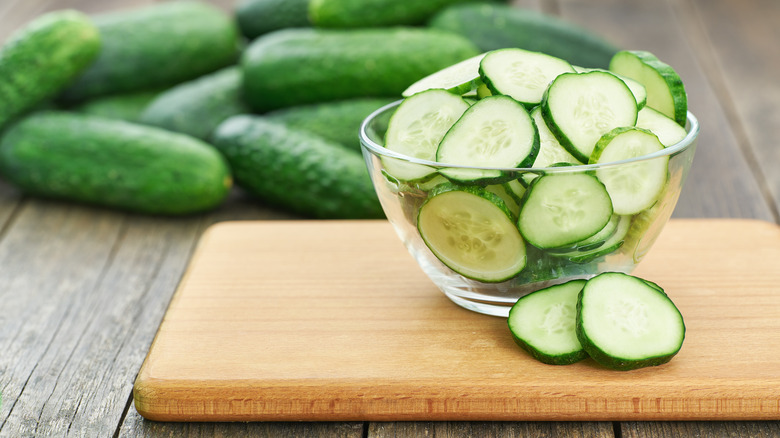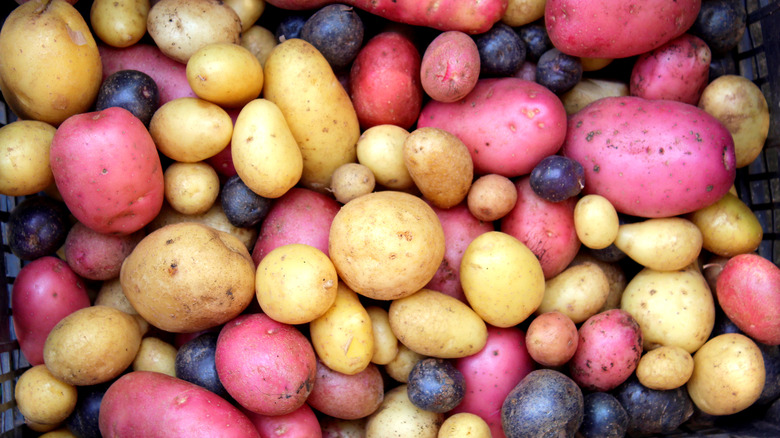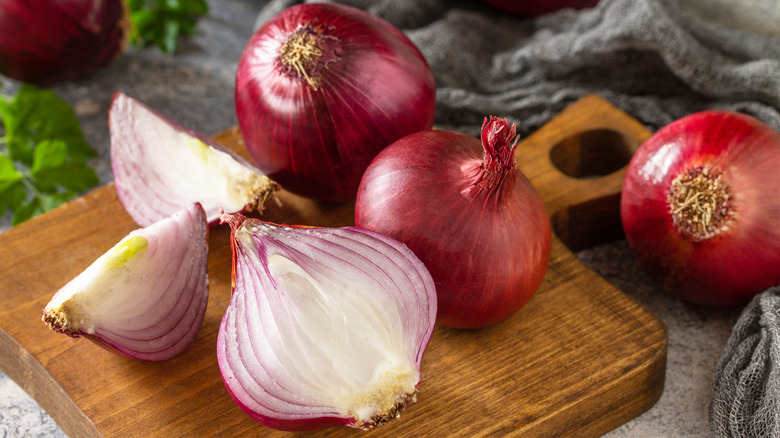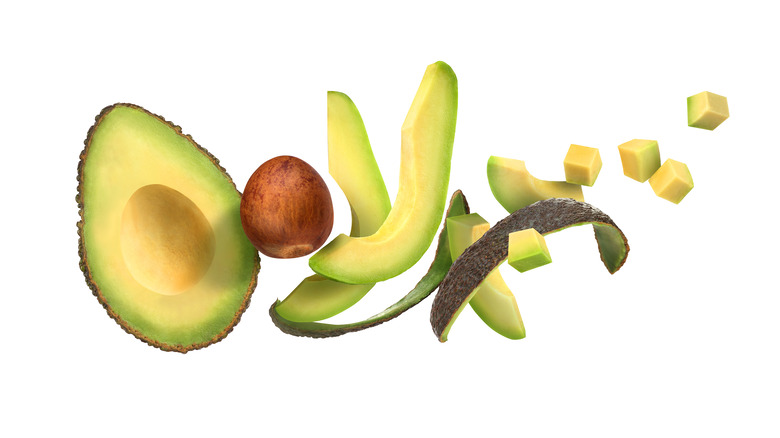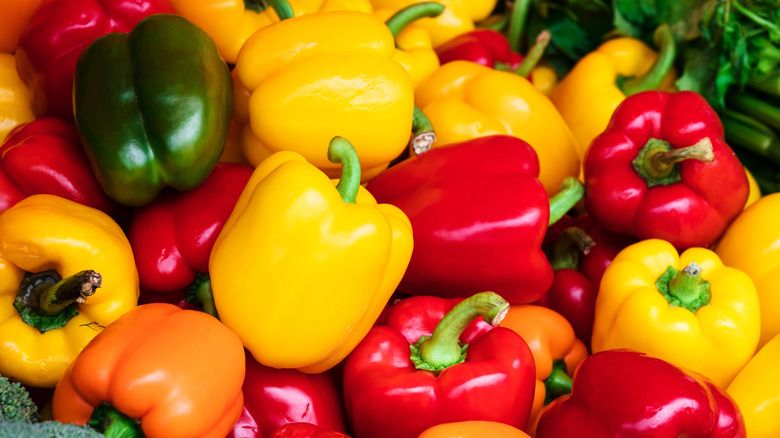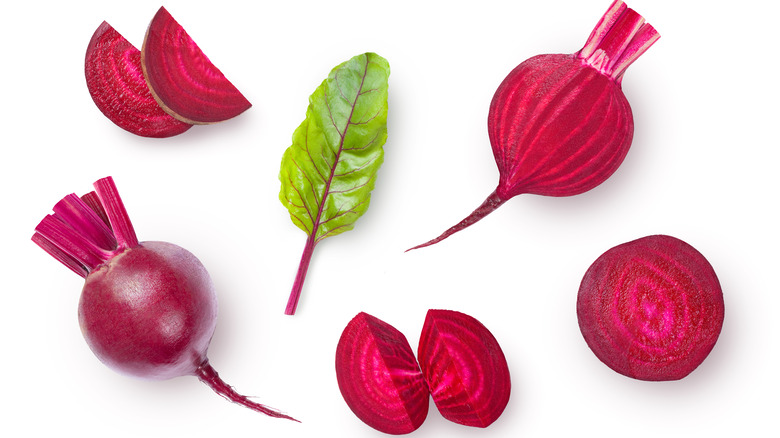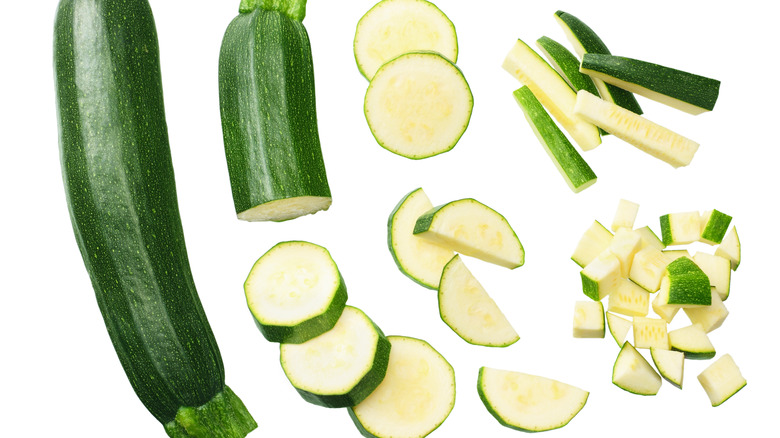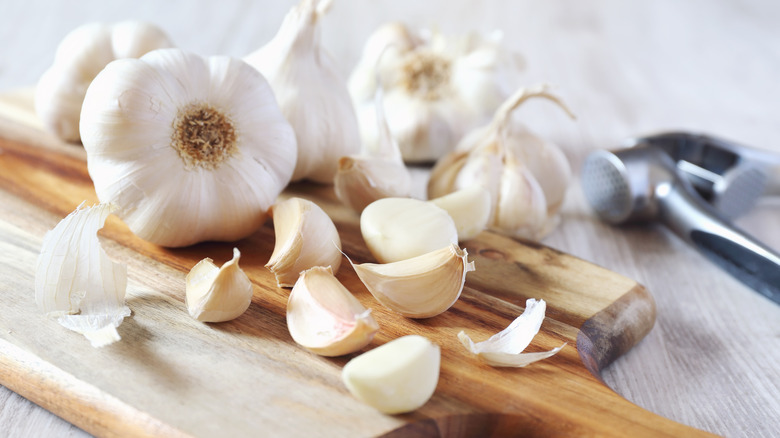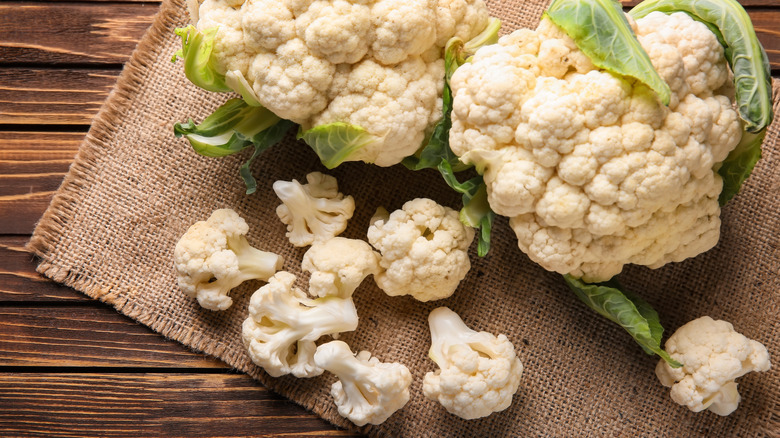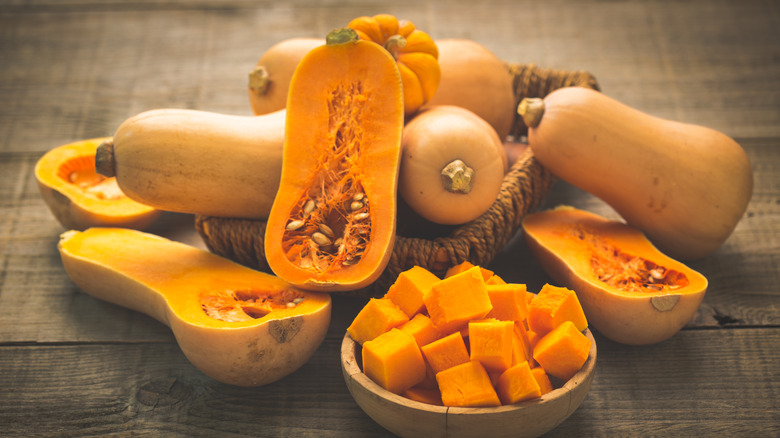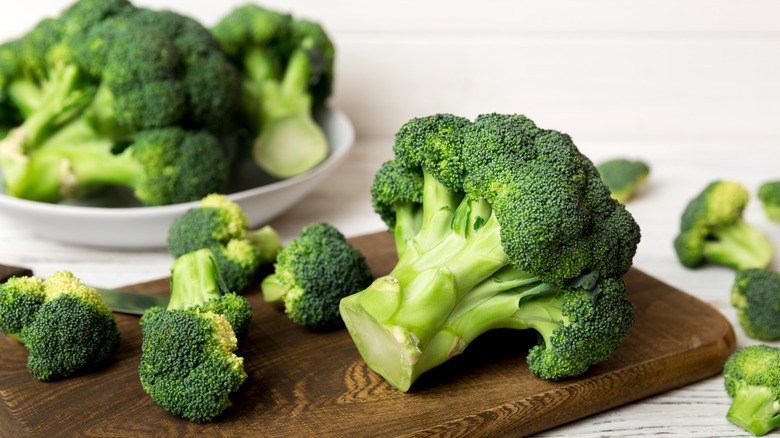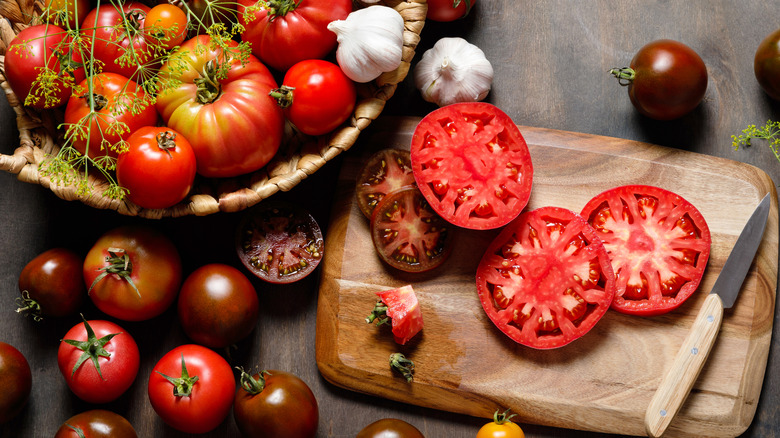You've Been Cutting These Vegetables The Wrong Way
Whether you're slicing, dicing, or mincing, knowing how to chop a vegetable appropriately is crucial. It's also intimidating, what with the sheer number of different types of knives out there. How do you know whether a particular vegetable will be easier to chop with a serrated knife versus a boning knife? How is a home cook meant to handle vegetables that require special treatment based on their unique texture or the recipe being used? With so many different approaches, recipes, and styles of cuisine out there, it's easy to cut vegetables the wrong way for years on end.
There are some basic fundamentals to keep in mind where chopping vegetables is concerned, which include choosing the right knife for the job at hand, keeping knives properly sharpened, using the right type of cutting board, orienting fingers correctly, and cutting vegetables into consistently-sized pieces. But we're taking things a step further by investigating the best ways to cut specific vegetables. There's no need to be afraid of a big sharp knife. In fact, once you master these basic skills, you'll be chopping like a pro.
Carrots
Carrots are one of the most uniquely versatile vegetables out there. They're key to a classic mirepoix, a great source of crunch in a salad, a marvelous side dish when sautéed or stir-fried, and a perfect addition to a roasted vegetable medley. The key to cutting carrots, per Cutco, is to use the correct knife. They recommend a Santoku knife, which is heavy enough to cut through the firm vegetable. Another rule of thumb, which translates to most vegetables high in sugar and starch, is to expose maximum surface area. The carrot's natural sugars will caramelize when cooked, yielding a sweeter flavor and enabling it to cook faster.
MasterClass not only provides a tutorial on more exotic cuts — like the batonnet and the brunoise — it reinforces the necessity of using a well-sharpened knife. While using a very sharp knife might seem scary, the reality is that a sharp knife is far less likely to cause injury than a dull one. The best way to keep a knife honed (short of having it professionally done) is a mechanical knife sharpener, which is easy to use and ensures that the blade is evenly sharpened on both sides.
Cucumbers
Cucumbers can be a somewhat controversial vegetable. According to the American Chemical Society, they contain a chemical called cucurbitacin, which give some varieties a faint bitterness. Luckily, centuries of cultivation have resulted in a wide variety of cucumbers, many of which have little to no bitter taste. Cucumbers also range widely in terms of seediness, skin thickness, and water content.
How should this cool, crisp, refreshing vegetable be cut? For ease of preparation when dicing or julienning cucumbers, Nature Fresh Farms recommends a sharp Santoku-style knife. No matter what you're creating with your cucumbers, you should always cut off their ends, then cut them in half lengthwise. This will create a flat surface on the cucumber, which prevents it from rolling around and being far more difficult to cut. It's also suggested that when you're chopping a myriad of vegetables for a salad, you should start with the cucumber — it's the easiest veggie to clean up after.
Eggplant
Eggplant intimidates even seasoned cooks. The vegetable's slightly bitter flavor and persnickety personality make some people avoid using it altogether. Knowing how to process eggplant is the key to removing its mystique. First, select a firm, smooth-skinned eggplant. The recipe often dictates what sort of knife should be used, per Misen. Generally speaking, globe eggplants — which are typically used for recipes like eggplant parmesan — are approximately 8 inches long, while smaller and thinner Asian eggplants are about 7 inches long. A longer knife is recommended, ranging from 7 to 10 inches in length for most eggplants.
A chef's knife or Santoku-style knife is ideal for raw eggplant, while a serrated knife is recommended for cooked eggplant. The specific type of cut you choose to make is contingent on the recipe you're following. Many layered eggplant dishes call for planks or slices, while sautés and stir fries often recommend cubes or sticks. However you slice it, you should always cut off the tough ends of the eggplant before processing it further.
Potato
Whether you're frying it, hash-browning it, mashing it, or making it into a salad, the versatile potato relies on proper cutting technique to serve its purpose. At its most basic, Cutco notes that using a knife that is lengthy enough to cut all the way through the potato is crucial. Again, a Santoku-style or chef's knife that is approximately 7 inches long is ideal. It's also important to make sure your potato is flattened out. Because of its shape, this vegetable can roll around easily, making it unsafe to process. If there isn't an obvious flat side of the potato to use, slice a small piece off one side to create a level surface. Finally, make sure you cut your potato into evenly sized portions, which will ensure consistent cooking time.
MasterClass adds that to keep potatoes from browning after they're peeled, you should place them into a bowl of chilled water. Diced, wedged, and sliced potatoes can also be soaked in water until you're ready to use them. Be sure to strain off the water and pat the potato segments dry before cooking them to remove any excess moisture.
Onion
Onions are the backbone of so many recipes, yet they can be tough to work with. Good fundamentals are crucial to successfully incorporating them into any dish. The Food Network illuminates the very basics of cutting, slicing, dicing, and mincing an onion. First, cut the non-root end of the onion off. Then cut the onion in half through the root. This will make it far easier to peel. From there, processing the onion is a simple matter of using a sharp chef's knife. By retaining the attached root, you will have a handle to hold onto, which will stabilize the onion as you cut it. This will also protect your fingers and keep the onion together.
When it comes to crying over an onion, there are a number of tried and true techniques that minimize the tears. The top three methods include cutting the onion underwater, freezing the onion for 15 minutes prior to cutting, and leaving the root end attached. Less effective methods include microwaving it, rubbing lemon juice on the knife blade, and refrigerating the onion for 30 minutes before hacking into it. We've also had some success with onion goggles. They'll make you look like you're getting ready to go skiing, rather than cook in your kitchen, but they're undeniably effective.
Avocado
While avocado is technically a fruit, it's used more like a vegetable in savory applications. According to BBC Good Food, there are four different types of avocados, with the Hass being the most popular and readily available. Aside from its luxurious texture and powerhouse nutritional profile, the avocado's allure is in its unusual composition. It has a relatively large pit and fairly sturdy skin that can be a challenge to get into. To safely access the avocado's creamy flesh, use a sharp chef's knife to score around the pit vertically until the avocado is separated into two halves.
To remove the pit, you can either use a teaspoon to scoop it out, or, as the Food Network suggests, take the heel of your knife and gently hack into the pit. Once inserted, twist the knife. The pit should easily come out of the avocado half. Though this is an efficient method, it can be dangerous if you aren't cautious. Holding the avocado half with a towel creates a safety barrier between your hand and the knife. Once pitted, you can either remove the peel by hand or scoop the meat of the avocado out with a spoon. Then you can slice, chop, or mash it into your favorite guacamole or avocado toast recipe.
Bell Peppers
Bell peppers can be a pain to cut, thanks to the little seeds that go flying everywhere if you don't approach it in just the right way. There are a number of techniques to avoid this, thankfully. MasterClass demonstrates the method we use most often, which is to start with the pepper stem up. Cut the flesh of the pepper lengthwise into four quarters, avoiding the stem. You'll be left with the seeds still attached to the core of the pepper, which is still attached to the stem, allowing for easy disposal.
YouTuber Free to Cook offers a slightly different technique that is equally as effective. This method cuts the top and bottom of the pepper off. Then a vertical incision is made down one side of the pepper. From here, each membrane is slowly sliced away from the meat of the pepper, which eventually yields one large, flat sheet of pepper that you can cut up accordingly. Whichever method you choose, once you have the pepper separated from the core, process it with further cuts, skin side down. This keeps the knife from accidentally slipping off the pepper.
Beets
Cooking with beets can make your kitchen look like a crime scene, due to their bright red juice. Luckily, there are ways of cutting beets that also keep your kitchen from looking like a haunted house. Cutco suggests using a large, serrated, heavy-duty blade to process the dense root efficiently. If you plan to use your beets raw, consider wearing gloves to cut them, to prevent staining. MasterClass also suggests rubbing the cutting board you use with salt to remove those crimson stains. If you do get beet juice on your hands, lemon juice will help lift the stains off your skin.
If you plan to use your beets cooked, boil them before peeling and slicing, then use a paper towel to rub the skin off. This will keep your hands clean. If you use fresh beets with the greens attached, don't discard them: They can be chopped up and cooked the same way you cook other greens, like collards or Swiss chard.
Zucchini
Zucchini is an amazingly versatile vegetable that many people underutilize. From stuffing to stir-frying to roasting, the zucchini can do it all. The key to embracing the chameleon-like qualities of the squash is learning how to cut it. Better Homes & Gardens illustrates this by discussing the five most basic ways to prepare zucchini: coins, noodles, strips, cored, and shredded. While they suggest investing in gadgets like a mandoline slicer and a spiralizer, many of the basic preparation techniques can be done using a sharp chef's knife and a box grater.
The key is to give this round vegetable a flat surface, making it easier to handle. This is accomplished by cutting off the ends of the zucchini, then cutting it in half lengthwise. We also love the coring technique, which utilizes a standard apple corer. If you do opt to purchase a mandoline slicer, use it with caution. They're razor sharp and can slice a part of your finger off as readily as they slice veggies. And while you're cutting this noble squash, don't forget the squash blossoms. They're ample during the summer months and a common ingredient in Italian cuisine.
Garlic
Garlic is a staple in many dishes, but getting it from the bulb into a dish can be a pain. Garlic makes your hands smell, is sticky to work with, and sheds its paper-like exterior everywhere. Instructables offers a few hacks to help speed the process of cutting garlic along without making much mess. A good quality chef's knife or Santoku-style knife is all that's needed. Once you pull the cloves off the head of garlic, place them on a cutting board. Use the wide end of the blade to smash the cloves one at a time. This will release the cloves from their papery skin, making them easier to peel and less sticky to handle. From here, you can slice, chop, or mince the garlic depending on what the recipe you're making calls for. Be careful to avoid prolonged contact between your skin and processed garlic, however — as The New York Times notes, this can cause serious irritation.
Cauliflower
Cauliflower is a work horse of the culinary world. From florets to rice to pizza crust, the humble veggie can do it all. But accessing its cruciferous yumminess requires a good chef's knife and a tiny bit of elbow grease. According to MasterClass, all cauliflower recipes begin with removing the leaves, then cutting off the dense stem. Once the stem has been removed, place the cauliflower stem side down onto a cutting board to stabilize it, then cut it in half. Florets can be removed individually by hand, or you can cut each half into steaks to be used for grilling or roasting.
To create cauliflower rice, Better Homes & Gardens suggests pulsing florets in a food processor, or grating a cauliflower half by hand using a box grater. The latter approach may take more time, but hey, you can always consider it part of your exercise routine. You can then take your riced cauliflower and turn it into a delicious low-carb pizza crust. Alternatively, you can buy pre-riced cauliflower, but it's nowhere near as flavorful. Moreover, cauliflower can turn brown after ricing if not used immediately.
Butternut squash
Butternut squash is the perfect fall food. It's low in fat, high in a myriad of vitamins and minerals, and low in calories, thanks to the fact that it's approximately 86% water, per MasterClass. But its seemingly impermeable hull makes it appear impossible to cook with, discouraging many from taking advantage of its culinary and nutritional abundance. Thankfully, a good, sharp knife makes processing this autumnal powerhouse easy. Simply cut off both ends of the squash, then cut it in half lengthwise. Once you have two halves, you can peel the skin off with a vegetable peeler. Using a large spoon, scoop out the seeds from each half. From here, you can cut the squash into cubes or simply slice it, depending on the recipe you're making.
An even easier method of tackling a butternut squash, according to Good Housekeeping, is to simply leave the skin on and roast the squash halves whole. This saves you the time and effort of peeling the squash. Moreover, the finished product can be stuffed with a myriad of ingredients, ranging from quinoa to ground beef. For added flavor, season your squash with a spice blend like ras el hanout before roasting to bring out its natural sweetness.
Broccoli
Whether you're trying to get the perfect floret for dipping in dressing or topping it with melted cheddar cheese, broccoli is delicious. Cutco has some recommendations for the best way to hack into a head of this versatile veggie. Because the florets are so tightly grouped together, a knife with a sharp tip is suggested. Once you cut the stalk off, cut the head in half. Then you can easily separate the florets with your knife. If you feel safer doing so, you can also cut the florets off the head with some sturdy kitchen shears.
Should you have a nice fresh head of broccoli with a substantial stalk in hand, don't discard the stalk — it has great flavor and texture all its own, per Masterclass. Before incorporating the stalk into a soup, salad, or stir fry, peel its outer layer off with a vegetable peeler. Then proceed to dice, julienne, or even shred the stalk with a microplane — the latter approach enables you to make a delectable spin on coleslaw.
Tomato
Technically, the tomato is a fruit, not a vegetable, but it's generally utilized in savory dishes. Cutting a tomato can be difficult, because of its delicate flesh: It's easily pulverized into goo before you get a single slice out of it. Using a serrated knife or an extremely sharp chef's knife to cut a tomato is critical to salvaging the integrity of this powerhouse ingredient. For perfect slices, simply tilt the tomato onto its side, cut away the stem, and slice. To cut it into wedges, start by cutting off the stem, then place the flat top of the tomato on your cutting board and quarter it.
Some recipes call for your tomato to be deseeded, which can be easily accomplished by either cutting the tomato in half and scooping out the seeds with a spoon, or by cutting the tomato into wedges and carefully scoring around the seeds to remove them. If you need a tomato peeled, simply score the bottom of the tomato with your knife and cover it with boiling water. This will loosen the skin enough that it practically slides right off. You have now mastered the art of preparing the luscious tomato for virtually any recipe, from a spicy salsa to a homemade marinara.
